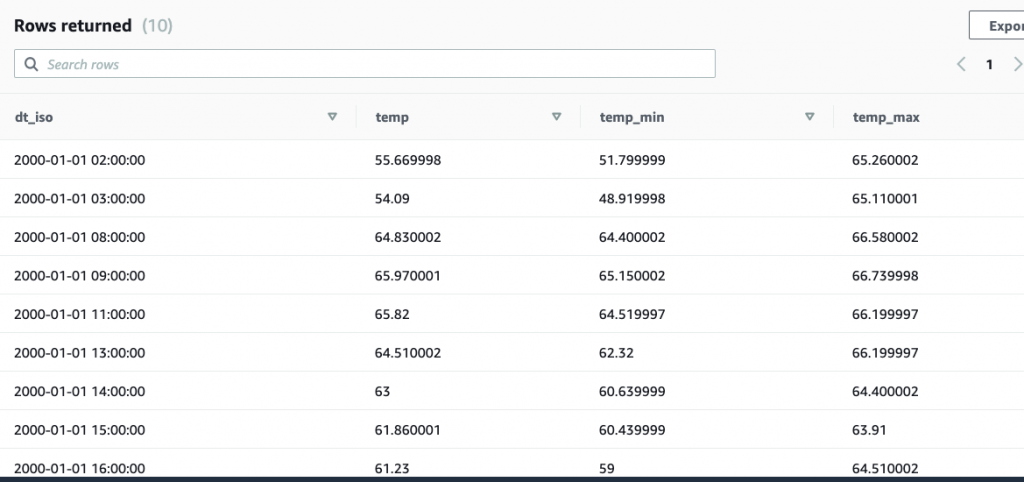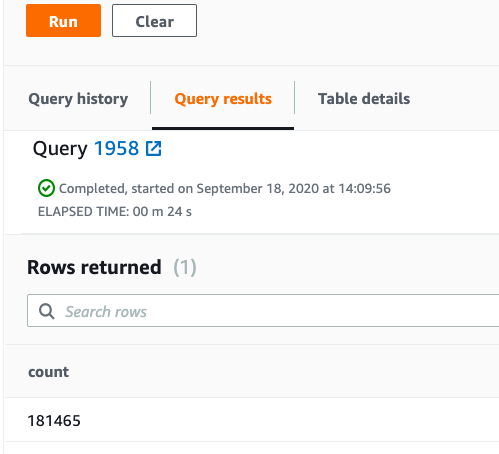Here we show how to load JSON data into Amazon Redshift. In this example, Redshift parses the JSON data into individual columns. (It is possible to store JSON in char or varchar columns, but that’s another topic.)
First, review this introduction on how to stage the JSON data in S3 and instructions on how to get the Amazon IAM role that you need to copy the JSON file to a Redshift table.
In this example, we load 20 years of temperature data for Paphos, Cyprus. We purchased that data for $10 from OpenWeather. Of course, you could use any data.
Create a Redshift Table
First we create a table. We only want the date and these three temperature columns. We will give Redshift a JSONParse parsing configuration file, telling it where to find these elements so it will discard the others.
create table paphos ( dt_iso timestamp not null distkey sortkey, temp real, temp_min real, temp_max real );
The weather data looks like this:
{
"city_name": "Paphos Castle",
"lat": 34.753637,
"lon": 32.406951,
"main": {
"temp": 55.35,
"temp_min": 51.8,
"temp_max": 65.53,
"feels_like": 49.44,
"pressure": 1016,
"humidity": 73
},
"wind": {
"speed": 9.17,
"deg": 20
},
"clouds": {
"all": 1
},
"weather": [{
"id": 800,
"main": "Clear",
"description": "sky is clear",
"icon": "01n"
}],
"dt": 946684800,
"timezone": 7200
}
Here is one record in the JSON Power Editor for Mac.
Note: I recommend this editor if you work with JSON a lot, as it makes editing JSON files a lot easier. You can work with objects in the right-hand screen which will create the text in the left-hand screen. That saves you the trouble of having to fix syntax error and line up curly brackets.

Create JSONPath file
We create a JSONPath file, which tells Redshift which elements to get. We have to give it the path of the item all the way down to the item. In other words, we can’t put just the top-level key weather and it will get temp, temp_min, and temp_max. We have to give it the full path of JSON keys main->temp.
We don’t have any arrays in this example, but it supports that using [array index] notation.
{
"jsonpaths": [
"$['dt_iso']",
"$['main']['temp']",
"$['main']['temp_min']",
"$['main']['temp_max']"
]
}
Prepare and upload JSON file to S3
This text file is 64 MB of daily weather records for the past 20 years. Unfortunately, it’s made all as one JSON array. So, we have to remove the first bracket and last bracket characters from the file.
Also, Redshift seems to require for the JSONP format that each record have a line feed at the end. Then means we need to insert a line feed for each. So, use these three sed statements to do that.
Note: JSONP file format means having one record right after another. So, taken together it’s not a valid JSON object. Instead it’s just a way to put many JSON objects into a file for bulk loading.
sed 's/^.//'
sed 's/.$//'
sed s'/,{"city/\n{"city/g'
Copy this file and the JSONPaths file to S3 using:
aws s3 cp (file) s3://(bucket)
Load the data into Redshift
We use this command to load the data into Redshift. paphosWeather.json is the data we uploaded. paphosWeatherJsonPaths.json is the JSONPath file.
copy paphos from 's3://gluebmcwalkerrowe/paphosWeather.json' credentials 'aws_iam_role=arn:aws:iam::xxxxx:role/Redshift' region 'eu-west-3' json 's3://gluebmcwalkerrowe/paphosWeatherJsonPaths.json';
Common errors
If you have formatted the text or JSONPaths table wrong or illogically you will get any of these errors.
The first says to look into select * from stl_load_errors for more details:
ERROR: Load into table 'paphos' failed. Check 'stl_load_errors' system table for details.
This error says we have five elements in the JSONPath file but have created a database table with 13 columns. Go back and fix those.
ERROR: Number of jsonpaths and the number of columns should match. JSONPath size: 5, Number of columns in table or column list: 13 Detail: ----------------------------------------------- error: Number of jsonpaths and the number of columns should match. JSONPath size: 5, Number of columns in table or column list: 13 code: 8001 context: query: 273 location: s3_utility.cpp:780 process: padbmaster [pid=20575] -----------------------------------------------
If you put all your JSON data into an array instead of the JSONP format it will be too large. Then you might get:
String length exceeds DDL length
Check the loaded data
Here we look at the first 10 records:
select * from paphos limit 10;

Here we count them. As you can see there are 181,456 weather records.
select count(*) from paphos;

Additional resources
For more on this topic, explore these resources:






